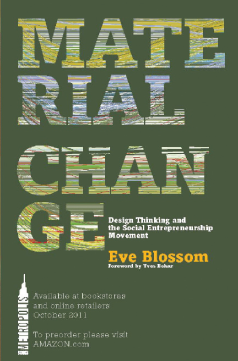By: Maria E. Luna Issue: Vision Section: Book Review
Eve Blossom’s Profitable Social Venture
It is absolutely necessary for both business and design to build sustainable social enterprise. So how do profitable social ventures get started? These are the basic foundations. Start with establishing a business that offers a product or service that is of personal interest and that a customer wants, this takes some experience.
Eve Blossom outlines a profitable social venture system in her book, Material Change, Design Thinking and the Social Entrepreneurship Movement. Taking a visceral reaction from a repugnant social condition, to researching facts, to what is really behind a problem requires a redesign of what leads society to a specific behavior. A social faux pas can be an opportunity for a social venture. Oftentimes, social ventures are structured as nonprofits so they lack equity, rarely become sustainable, and have low if any financial yield. Blossom, a successful social entrepreneur has developed a system for making social ventures profitable. She says, systems designs can be applied to many things like structures in a building, a product, or a business, and as such, a system can be designed to make social ventures profitable.
“Design is now understood as an approach, a way to view the world and create an ongoing lifestyle,” she says. An item’s lifecycle is the most important element in getting a product or service to be desired by a customer. Being a customer is termed more responsible than a consumer, because, she argues, “Being a customer unites people in shared experiences.” The design approach is more than making a product aesthetically pleasing but it’s about, “Building a smarter framework of ecological, economic and social sustainability. It’s about deep systematic engagement,” Blossom asserts. In Material Change she says, “Design can also change the fundamental building blocks of business.” The building blocks are worth consideration because the alternative is uncivil—observing unemployment, human trafficking, and child labor injustices.
One way to go about creating a social venture is to keep in mind the following practices. Consider the entire lifecycle of a product or service from raw materials to disposal. Focus first on developing the most sustainable areas and then address the smaller issues, like designing new products for the end of the lifecycle by ensuring that materials in the product last longer or are reusable. Ensuring the transparency of product development is also important, as customers often want to engage in the larger sustainability experience.
The hidden trade-offs of many products can anger customers—trade-offs like child work houses, slavery, and work for room and board without wages. Balancing an item’s “true cost” to its price is becoming a trend, as well as purchasing value-driven products. Hidden costs can also be dangerous. Take for example finding a terrific sale on a DVD player for five dollars. Parts and labor surely cost more than five dollars. So what are the hidden costs a customer doesn’t see? Is it possible the hidden costs are pollution, increased exposure to carcinogens, unfair labor wages, no wages, or slavery?
There is good news too! An example of a sustainable company is Whole Foods, an international, $8 billion dollar organization with 54,000 employees who work towards creating a better person, company, and world. Their motto is, “Whole Foods, Whole People, Whole Planet—our vision reaches far beyond just being a food retailer. Our success in fulfilling our vision is measured by customer satisfaction, team member excellence and happiness, return on capital investment, improvement in the state of the environment, and local and larger community support.” They are a prime example of a truly sustainable enterprise. They are a great example of how companies can encourage and ensure ethical production.
Blossom’s book also tells the story of collaboration between designers and artisans working in a for-profit social venture. Lulan is that for-profit social venture which employs artisans in Asia and India to prevent human trafficking. Blossom identifies six components that create sustainability at Lulan including ecological, economic, social, cultural, communal and personal elements. Lulan also allows employees to choose benefits that suit them best such, like giving housing allowances or educational opportunities. Material Change takes an in-depth look into all six components and their success.
Blossom, a “disruptive entrepreneur” describes other disruptive entrepreneurs as spirited business leaders who are redesigning method and models with meaning and profitability. A disruptive entrepreneur is someone who will, “Collaborate, excite, inspire, create, include, modify, adapt, and redefine.” The disruptive entrepreneur erases the singular genius hierarchy and uses collaboration for stronger results. When applied correctly this type of collaboration draws people in, new ideas develop, and profitable partnerships begin. Furthermore, roadmaps are offered in the book, offering guiding materials for social entrepreneurs. Additionally, Blossom is launching a new website offering products made using the profitable social venture system. These items can be found at http://www.wevebuilt.com.
Blossom believes that collaborative social entrepreneurship can build a, “Container of collaboration, a place where rich relationships and partnerships can flourish, a place that becomes stronger than you ever imagined, it’s like an invitation to a really cool party.”
Material Change, Design Thinking and the Social Entrepreneurship Movement is available at bookstores and online retailers.

